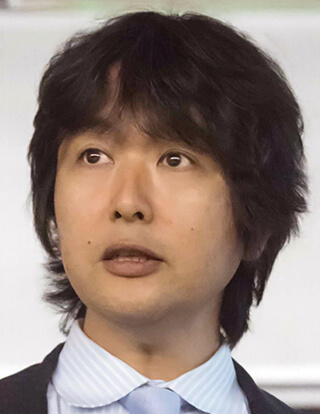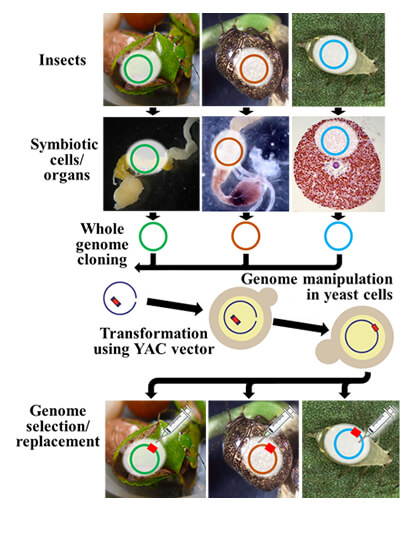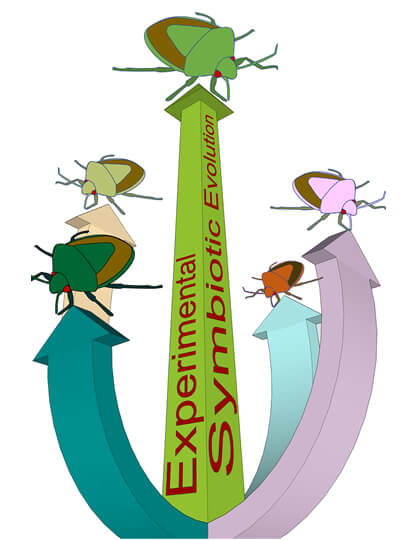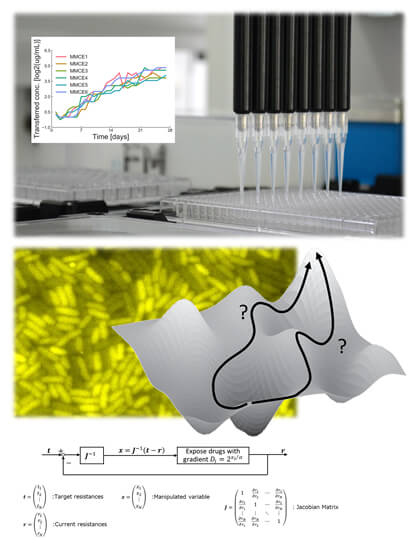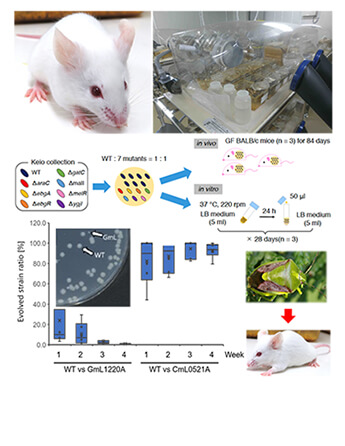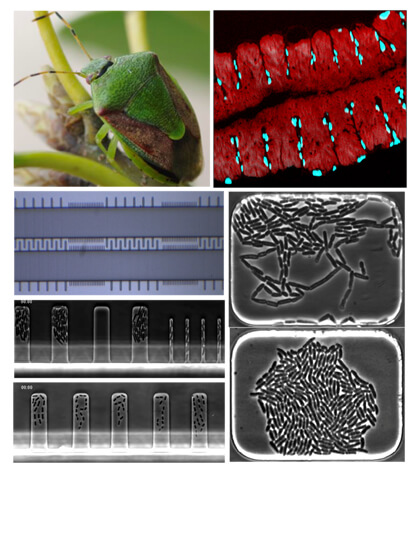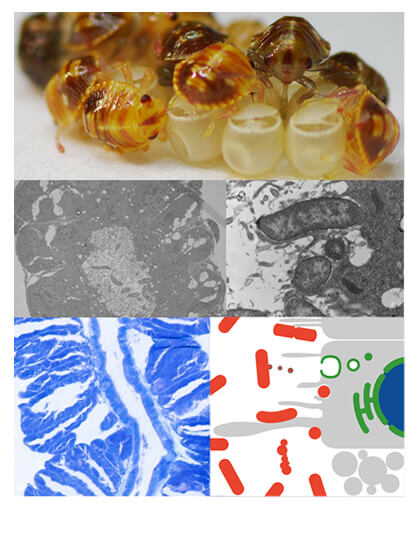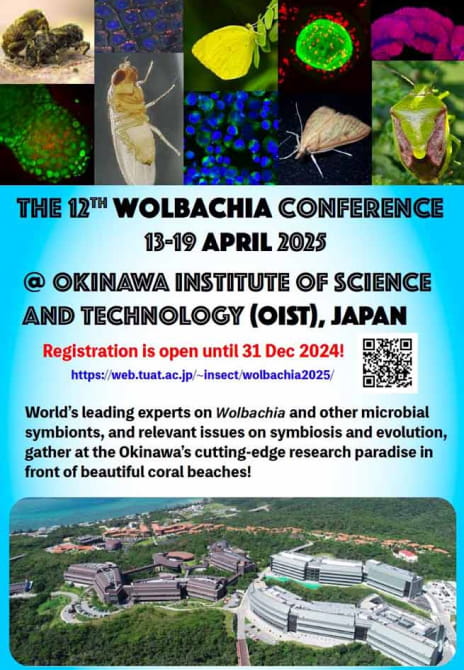We attempt to understand the mechanisms of symbiosis using experiomental evolutionary approaches.
Last updated: November 30, 2024
PROJECT
ERATO Evolving Symbiosis Project aims at bringing about breakthroughs in our understanding of symbiosis, by making use of our novel insect-E. coli and mammal-E. coli experimental symbiotic systems, and also by applying the recent genome engineering technologies, thereby focusing on the diversity and commonality of the symbiotic mechanisms encompassing invertebrates and vertebrates.
RESEARCH GROUPS
NEWS
ERATO Evolving Symbiosis Project International Seminar Series #34
Dr. Nicky Wybouw(Ghent University, Belgium)
“How Wolbachia symbionts spread within haplodiploid mites”
ERATO Evolving Symbiosis Project International Seminar Series #33
Dr. Joseph Parker (California Inst. Tech., USA)
“Retracing the Evolutionary Steps Towards Symbiosis”
ERATO Evolving Symbiosis Project International Seminar Series #32
Dr. Aileen Berasategui (Amsterdam Institute for Life and Environment, Netherland)
“Origin and evolution of a defensive symbiosis in tortoise beetles”
ERATO Evolving Symbiosis Project International Seminar Series #31
Prof. Saskia Hogenhout (John Innes Centre, UK)
“Unveiling the Influence of Phytoplasmas: Insights into Extended Phenotypes and Biotechnological Implications”
ERATO Evolving Symbiosis Project International Seminar Series #30
Prof. Thomas Richards (University of Oxford, UK)
“Insights into mediation between endosymbiotic partners within Paramecium bursaria”
The following video is uploaded to the YouTube channel “ERATO FUKATSU Evolving Symbiosis Project”.
“Experimental evolution of microorganisms in laboratory”
The following video is uploaded to the YouTube channel “ERATO FUKATSU Evolving Symbiosis Project”.
“Symbiont capsules made by plataspid stinkbugs”
The following video is uploaded to the YouTube channel “ERATO FUKATSU Evolving Symbiosis Project”.
“Coevolution of bat flies, endosymbiotic bacteria, and host bats”
ERATO Evolving Symbiosis Project International Seminar Series #29
Prof. Evan Economo (Okinawa Institute of Science and Technology, Okinawa, Japan)
“Biodiversity science in the era of big data: treasure maps, trap-jaws, and the metaverse”
The following video is uploaded to the YouTube channel “ERATO FUKATSU Evolving Symbiosis Project”.
“Blood-sucking lice and their symbiotic bacteria”
The interview video of Takema Fukatsu, the ERATO Research Director, by Prof. Thomas Bosch (Univ. Kiel, Germany) is on the YouTube.
Interview: Takema Fukatsu, Tokyo/Tsukuba University, Insect-Microbe Symbiotic Systems}
The following video is uploaded to the YouTube channel “ERATO FUKATSU Evolving Symbiosis Project”.
“Intracellular symbiotic bacteria of cockroaches”
ERATO Evolving Symbiosis Project International Seminar Series #28
Dr. Brian Trevelline (Kent State University, USA)
“Microbiome-mediated phenotypes in wild vertebrates”
ERATO Evolving Symbiosis Project International Seminar Series #27
Dr. Tom Bourguignon (Okinawa Institute of Science and Technology, Okinawa, Japan)
“Evolution of termites and cockroaches with their bacterial symbionts”
ERATO Evolving Symbiosis Project International Seminar Series #26
Dr. Harald Gruber-Vodicka (Kiel University, Germany)
“Symbiosis as a driver of placozoan biology?”
ERATO Evolving Symbiosis Project International Seminar Series #25
Dr. Michael Baym (Harvard Medical School, USA)
“Acellular pressures on plasmid evolution”
ERATO Evolving Symbiosis Project International Seminar Series #24
Prof. Gregg Howe(Michigan State University, USA)
“Hormones from lipids: Control of plant-biotic interactions by jasmonate”
ERATO Evolving Symbiosis Project International Seminar Series #23
Dr. Federica Calevro (BF2i lab, INRAE – INSA Lyon, University of Lyon, France)
“Evolutionarily conserved metazoan pathways have evolved new functions in the context of symbiotic interactions”
ERATO Evolving Symbiosis Project International Seminar Series #22
Prof. Michele Nishiguchi (University of California Merced, USA)
“Interpreting the road map between ecological and molecular boundaries using a squid-bacterial mutualism”
ERATO Evolving Symbiosis Project International Seminar Series #21
Dr. Filip Husnik (Okinawa Institute of Science and Technology, Okinawa, Japan)
“Organellogenesis: Provide, Divide, and Rule”
ERATO Evolving Symbiosis Project International Seminar Series #20
Prof. Colin Dale (The University of Utah, USA)
“Utilizing Sodalis-allied symbionts to probe evolutionary and molecular questions in symbiosis”
ERATO Evolving Symbiosis Project International Seminar Series #19
Prof. Ehab Abouheif(McGill University, Canada)
“How ants and bacteria became one”
ERATO Evolving Symbiosis Project International Seminar Series #18
Dr. Philipp Engel(University of Lausanne, Switzerland)
“Specialized gut microbiota-host interactions in social bees”
ERATO Evolving Symbiosis Project International Seminar Series #17
Dr. Angad Mehta(University of Illinois at Urbana-Champaign, USA)
“Directed endosymbiosis for evolutionary studies and synthetic biology”
The following paper was published in Nature Microbiology.
Koga R, Moriyama M, Onodera-Tanifuji N, Ishii Y, Takai H, Mizutani M, Oguchi K, Okura R, Suzuki S, Gotoh Y, Hayashi T, Seki M, Suzuki Y, Nishide Y, Hosokawa T, Wakamoto Y, Furusawa C, Fukatsu T. (2022) Single mutation makes Escherichia coli an insect mutualist.
Nature Microbiology 7(8): 1141-1150.
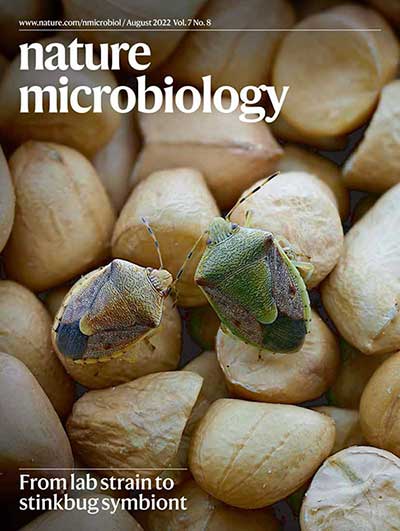
The following News and Views in Nature Microbiology highlighted Koga et al. (2022).
Kaltenpoth M. (2022) Fast track mutualism. Nature Microbiology 7: 1104-1105.
The following video is uploaded to the YouTube channel “ERATO FUKATSU Evolving Symbiosis Project”.
“Symbiont-containing “egg-covering jelly” of urostylidid stinkbugs”
The following video is uploaded to the YouTube channel “ERATO FUKATSU Evolving Symbiosis Project”.
“Welcome to Our Laboratories 〜ERATO Research Centers〜”



